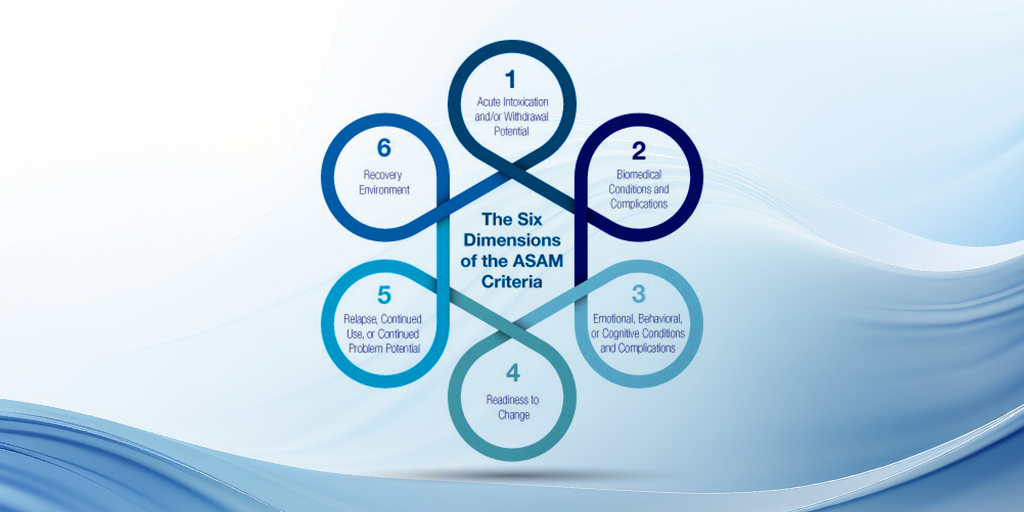What are the Six Dimensions in the ASAM Criteria 3rd Edition?

The ASAM Criteria are the most widely used guidelines for assessment, service planning and placement for individuals with addiction and co-occurring conditions. The Change Companies published the third edition of The ASAM Criteria in 2013. The dimensions are updated in The ASAM Criteria 4th Edition.
The six dimensions of The ASAM Criteria 3rd Edition are:
| 1 | Acute Intoxication and/or Withdrawal Potential |
| 2 | Biomedical Conditions and Complications |
| 3 | Emotional, Behavioral or Cognitive Conditions and Complications |
| 4 | Readiness to Change |
| 5 | Relapse, Continued Use or Continued Problem Potential |
| 6 | Recovery and Living Environment |
In ASAM’s multidimensional assessment, the six dimensions are used to summarize a person’s needs, define severity and develop a treatment plan. Clinicians use the dimensions to identify problems, goals and treatment plan objectives.
In each of the six dimensions, clinicians assign a risk rating for an individual’s situation. While evaluating current problems, treatment professionals also consider unique skills, strengths and resources that can help each person deal with his or her challenges. On the risk rating scale from 0 to 4, a rating of 0 represents very low risk. On the opposite end, a rating of 4 represents imminent danger or an issue of utmost severity.
Throughout the assessment, clinicians weigh a person’s past experiences – history – against current symptoms – the here and now. The individual’s here-and-now experiences always receive priority. For example, a person who has no withdrawal symptoms after a few days without drugs or alcohol would receive a low-risk rating for acute intoxication and withdrawal potential, even if he or she has a history of severe withdrawal symptoms.
The Six Dimensions of The ASAM Criteria 3rd Edition:
1. Acute Intoxication and/or Withdrawal Potential
The first dimension explores an individual’s past and current experiences of substance use and withdrawal. No longer called “detoxification,” withdrawal management encompasses a range of services designed to meet a person’s biopsychosocial needs.
2. Biomedical Conditions and Complications
The second dimension explores an individual’s health history and current physical condition. The goal is to determine whether the person needs additional physical health services, from acute stabilization to ongoing management of a chronic condition.
3. Emotional, Behavioral or Cognitive Conditions and Complications
The third dimension explores an individual’s thoughts, emotions and mental health issues. This may include cognitive, behavioral, psychiatric and trauma-related conditions.
When considering the third dimension, it’s important to determine whether signs and symptoms can be addressed safely through addiction treatment (i.e., mood swings due to drug use) or warrant additional mental health services (i.e., mood swings due to concurrent bipolar disorder).
Dimension 3 also identifies five subcategories known as risk domains. These include: dangerousness/lethality, interference with addiction recovery efforts, social functioning, ability for self-care and course of illness.
4. Readiness to Change
The fourth dimension explores an individual’s readiness and interest in changing. Leaning on the transtheoretical model of behavior change (TTM), this dimension helps clinicians develop individualized care for people based on their readiness to change. The goal is to engage people in their own behavior change, providing motivational enhancement services as necessary.
It’s important to recognize people may show different levels of readiness to change for different issues. An individual may be already making changes in one area of his or her life while still seeing no problem with another self-destructive behavior.
5. Relapse, Continued Use or Continued Problem Potential
The fifth dimension explores an individual’s unique relationship with relapse, continued use or continued problems. This dimension is relevant at any stage of treatment – even if a person has not achieved a level of recovery that would seem to allow for relapse.
6. Recovery Environment
The sixth dimension explores an individual’s recovery or living situation, including the surrounding people, places and things. A person’s needs could include housing, financial, vocational, educational, legal, transportation or child care services. Clinicians also examine whether family members, significant others or school, work and living situations pose a threat to the person’s treatment and recovery.
Interactive Journaling®: An Individualized Method for Behavior Change
The Change Companies® has worked with top researchers for 30 years to stay on the leading edge of behavioral and mental health science, including David Mee-Lee, MD, chief editor of The ASAM Criteria 3rd Edition. We are in a unique position to help clinicians implement the ASAM Criteria. We offer the only ASAM-endorsed online training, and our participant-centered Interactive Journals incorporate key evidence-based practices.
“Interactive Journaling® finds the right balance of the structure of EBPs with the central importance of the therapeutic alliance to enhance positive self-change.”
David Mee-Lee, MD, chief editor of The ASAM Criteria
Interactive Journaling® is a structured and experiential writing process that motivates and guides participants toward positive life change. Created with support from more than 250 professionals in the health and human services fields, these materials rest on a solid research foundation. They are compatible with the ASAM dimensions and have underpinnings in motivational interviewing, cognitive-behavioral therapy, expressive writing and the transtheoretical model of behavior change. Consider the MEE Journal System or the Keep It Direct and Simple Journal System for materials that specifically align with the six dimensions and focus on positive, strength-based strategies.

